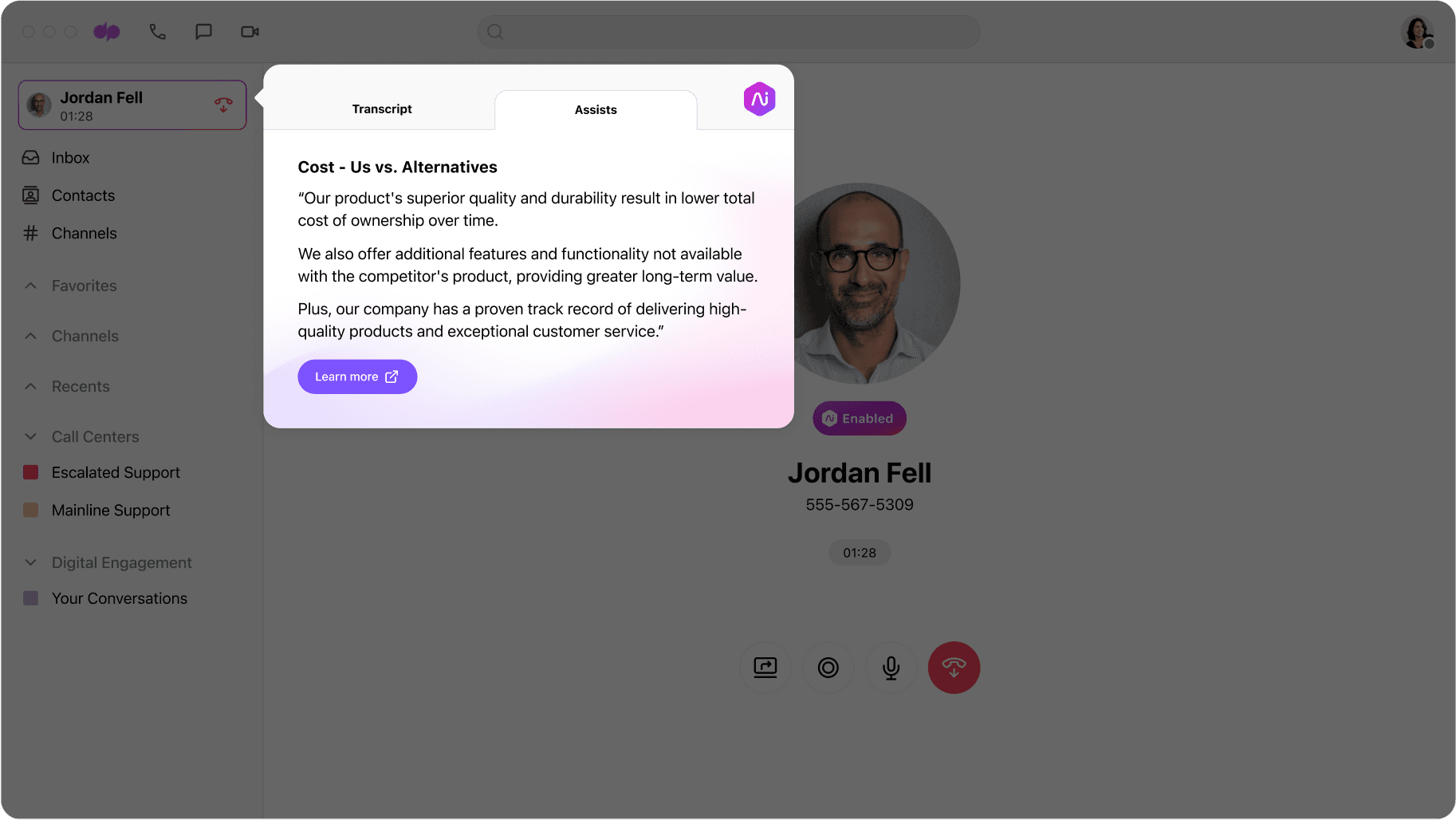9 Key sales performance metrics to track to keep your team as productive as possible

Director of Sales Development at Dialpad

Tags
Share
There is a huge variety of sales performance metrics out there, and it’s just not possible—or even advisable—for every sales team to be measuring each and every single one. More data isn’t always better. It is expensive and time-consuming to manage data overload, and often it isn’t necessary.
Depending on factors like the size of your company, the size of your sales organization, your sales cycle, and what you’re selling, the specific sales performance metrics you keep track of will be different (sometimes even when comparing against other competitors in your industry).
So, how can you measure the right sales performance metrics to uncover actionable insights into the effectiveness of your sales strategies, identify areas for improvement, and align sales efforts with overarching business goals?
Below, we’ll look at how to measure sales performance effectively, and some key metrics to consider that will help you make informed decisions that drive profitability and long-term success.
Understanding how to measure sales performance
Sales performance refers to the effectiveness and efficiency of a sales team or individual in achieving predefined goals and objectives.
The most common way to measure sales performance is by using metrics that quantify outcomes such as revenue generated and conversion rates. There are, of course, qualitative ways to assess performance as well. For example, our sales team uses Dialpad Ai Sales to gather conversation intelligence from our everyday sales calls.
Dialpad Ai can identify and track when certain keywords and phrases are spoken on calls with prospects, which is extremely helpful when we’re assessing how sales reps are performing at every stage of the sales process, from cold calling to closing.
For example, if I wanted to see how good an SDR is at booking demos for AEs, I can create a “Custom Moment” in Dialpad. A Custom Moment is a feature that lets you monitor how frequently a keyword or phrase pops up in conversations.
In this case, I could create a Custom Moment for keywords like “demo,” “booked,” or “discovery”:

Dialpad Ai will then track every time these keywords are said on sales calls. I can then see these instances in the sales analytics dashboard and click into those specific calls to either listen to the recording or read the transcript to get a sense of how those sales reps performed when trying to book demos.
In general, it’s good to have a mix of both quantitative or qualitative data when measuring sales performance because it gives you a more complete picture. When you’re assessing performance at scale, though, having the numbers to support your thesis or claim is vital.
What are sales performance metrics?
Sales performance metrics are quantitative measurements used to gauge the performance and effectiveness of sales efforts. Technically, they’re not the same as sales activity metrics, which focus on activities like calls made or emails sent, although sometimes a sales org will include sales activity metrics as part of its sales performance metrics. Your sales performance assessment should never just consist of sales activity metrics, though.
Sales performance metrics are also different from customer satisfaction metrics, which assess things like customer happiness and loyalty. Again, there might be a bit of overlap—your customer experience team might track customer churn, which could also be tracked as part of your key metrics for sales performance. (If your sales reps are selling to the wrong target persona, it may lead to high customer churn. In other words, it’s not just Customer Support’s problem.)
What are the benefits of tracking the right sales performance metrics?
There are a few key benefits of using and measuring sales performance metrics that are tailored to your sales org and business. These include:
More accurate performance evaluation: Metrics help provide an objective assessment of sales team performance. You may have reps who are great talkers, but talkers aren’t necessarily closers—if they don’t close, the data will show it.
Easier to identify trends: Metrics are also a good early indicator of things you may need to be worried about or opportunities to jump on. (Are we losing a lot of head-to-heads against Competitor X? Maybe that’s something we need to talk to the Product team about in case we’re lacking an important feature.)
Identifying coaching opportunities: Performance metrics are incredibly helpful for pinpointing areas where sales reps can improve and excel. By analyzing the habits and techniques of top performers, you can identify key behaviors and strategies that lead to success, enabling you to coach other team members to replicate these methods.
Better decision making: Sales performance metrics can also inform strategic decisions on resource allocation and process improvements. One region may be outperforming another drastically, which may be a sign that we need to take a closer look at training or hiring to bring the under-performing region up to speed.
More alignment on goals: Tracking the right metrics is crucial for ensuring alignment on business objectives and sales targets. For example, if Marketing is overdelivering on its leads goal and hitting 125%, but Sales is closing on 13% of them, that’s a clear sign that the lead profile for our marketing campaigns is not the right fit and those leads are not going to be good long-term customers.
Again, the right metrics will differ from one business to the next, but regardless of which specific metrics you’re measuring, these benefits should carry through across the board.
Now, let’s look at the sales performance metrics themselves.
9 Key metrics to measure sales performance
There are many more sales performance metrics than this, like referral rates, upsell rates, and so on. The best thing to do is to do a close analysis of your team’s specific processes and which ones may need a little more help and more granular guidance.
In general though, here are nine sales performance metrics to consider tracking, along with calculations for each one. This will help you get started on the right foot with sales reporting—if, over time, you find that you’re not getting a ton of value out of measuring one or two of these, you can always replace it with another performance metric.
Company-level sales performance metrics
1. Total revenue
Total revenue refers to the overall income generated from sales within a specific period—typically monthly, quarterly, or annually.
Total revenue is a fundamental metric that’s relevant no matter what industry you’re in, because it’s a key indicator of the financial health and overall success of a business. It reflects the effectiveness of sales strategies, market demand for products or services, and business growth, which means that every team has a role to play in making sure this metric is healthy—not just Sales.
How to calculate total revenue
Add up all sales revenue generated during the defined time period.
2. Net Revenue Retention (NRR)
Net Revenue Retention, or NRR, is a SaaS metric that measures the percentage of revenue retained from existing customers over a specific period, accounting for upsells, expansions, and churn. If you’re not running a SaaS or subscription-based business, skip this one.
NRR is crucial for SaaS because it indicates how well the company is retaining and growing revenue from its existing customer base. A high NRR suggests strong customer loyalty, a good product, and effective upselling strategies.
How to calculate NRR
NRR = (Revenue at end of period from existing customers / Revenue at start of period from existing customers) ×100
3. Average Customer Lifetime Value (CLV or LTV)
Average Customer Lifetime Value predicts the average revenue a customer will generate throughout their relationship with the company—which ideally will last for years.
LTV helps businesses understand the long-term value of acquiring a customer and guides decisions on customer acquisition costs (CAC) and retention strategies. For example, if it costs your business $150 to earn the average customer, but their overall LTV is only $35, then you’d need to significantly reduce your cost per acquisition—or make sure each customer spends a lot more with you over the course of their relationship with your company.
How to calculate LTV
LTV = Average Revenue per Customer × Average Customer Lifespan
Team or individual rep-level sales performance metrics
4. Win rate
Win rate measures the percentage of sales opportunities that result in closed deals.
Win rate indicates the effectiveness of the sales team in converting leads into customers. A higher win rate signifies strong sales performance, specifically effective lead qualification and good closing processes.
How to calculate win rate
Win rate = (Number of Total Opportunities / Number of Won Opportunities) × 100
If you need to improve win rates, having qualitative data in addition to metrics data can be useful. For example, we use Dialpad's Ai Scorecards to quickly review calls and see if reps did everything listed on the scorecard criteria according to our sales methodology.
For example, if we’re experiencing low win rates, we may want to verify that our reps are consistently asking about buying timelines. We can add “Seller asked prospect about timelines" to our Ai Scorecard criteria, which will then trigger Dialpad Ai to track sales conversations and detect if that action is being done on calls.
If a rep asks about timelines, then the coach who reviews that call will see right away that this was done:

It’s a huge timesaver, and can help speed up the sales performance assessment process dramatically if you have leaders who are overseeing especially large groups of sellers.
5. Quota attainment
Quota attainment measures the percentage to which sales representatives or teams achieve their assigned sales targets or quotas.
Quota attainment is important because it doesn’t just assess sales performance against set goals—your reps aren’t the only ones on the hook for this metric.
Setting a realistic but challenging quota is a huge performance management decision that requires a high level of skill in itself, and the quota attainment metric is also key to informing and guiding compensation and resource allocation.
How to calculate quota attainment
Quota Attainment = (Assigned Sales or Revenue / Assigned Quota or Target) × 100
6. Deal slip rate
Deal slip rate measures the percentage of deals that are delayed or pushed from one sales stage to the next without progressing.
Deal slip rate is an essential metric, especially for high volume sales teams, because it highlights inefficiencies in the sales process such as bottlenecks or issues in deal progression, and helps leaders identify areas for improvement.
How to calculate deal slip rate
Deal Slip Rate = (Number of Deals Slipped / Total Number of Deals) × 100
Process or pipeline sales performance metrics
7. Conversion rate
Conversion rate is another common metric (you’ll come across it often in call center metrics and KPIs) that measures the percentage of leads or prospects that convert into paying customers.
Conversion rate indicates the efficiency of your sales funnel and the effectiveness of lead nurturing and sales strategies. If leads aren’t converting, it may be a performance issue with reps, but it may also point to the need to improve training and coaching, or potentially issues with the lead qualification process.
One thing that can really help reps improve conversion rates is Dialpad Ai Agent Assist, which is a feature that pops up helpful notes and even links and media for sales reps when certain keywords are spoken.
Let’s say your sellers come up against Competitor “X” often, and aren’t always prepared to talk about how your product is better than your competitor’s. Ai Agent Assist will instantly search your connected knowledge bases (like battle cards, PDFs, and even unstructured sources like past sales conversations) for helpful notes on how to position you against Competitor X.
This information will then pop up on reps’ screens whenever a prospect brings up Competitor X’s name on a call. This way, even inexperienced reps can confidently handle questions and objections about almost every topic—which ultimately leads to higher conversion rates:

How to calculate conversion rate
Conversion Rate = (Number of Conversions / Number of Leads or Prospects) × 100
8. Customer Acquisition Cost (CAC)
Customer Acquisition Cost calculates the average cost to acquire a new customer, including sales and marketing expenses.
As I touched on earlier, CAC helps businesses evaluate the efficiency and scalability of customer acquisition strategies, ensuring profitability and sustainable growth. Everyone wants a low CAC, but the key is to balance CAC with LTV. Sometimes you may have what looks like an incredibly expensive CAC at $1,000, but if you’re selling an enterprise product or that customer’s deal is worth five figures, that high CAC would be well worth it.
How to calculate CAC
CAC = (Total Sales and Marketing Expenses / Number of New Customers Acquired)
9. Year-over-Year (YoY) growth
Year-over-year growth measures the percentage change in revenue or sales performance from one year to the next.
Ideally, you’ll want consistent YoY growth—which is easier said than done, especially when there are macroeconomic conditions you can’t control.
To attain healthy YoY growth, the business generally has to achieve a balance of assessing growth trends well, expanding strategically into new markets, and setting smart goals relative to previous periods.
How to calculate YoY growth
YoY Growth = (Current Year Revenue − Previous Year Revenue) / Previous Year Revenue ×100
How the right sales engagement solutions can help you track your sales performance metrics
Tracking and analyzing sales performance metrics is essential for refining your sales strategies, improving reps’ productivity, and achieving sustainable growth.
By focusing on the key sales performance metrics that align with your org, you can gain valuable insights into sales processes, make data-driven decisions, and ultimately drive success in competitive markets.
Learn how Dialpad Ai Sales can help your reps and leaders hit their sales performance metrics consistently, quarter over quarter!








